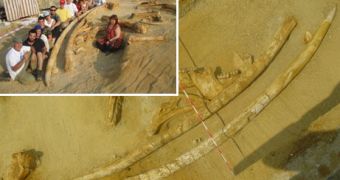In modern day elephants, tusks rarely exceed 3.5 m (12 ft) in length in African male champions. In mammoths, this was the norm. But recently, in northern Greece, 250 mi (400 km) north of Athens, researchers have discovered two massive tusks of a prehistoric mastodon that roamed Europe over 2 million years ago and which could be the largest ever found.
Mastodons were related with the elephants (and with the mammoths), from which they split off about 25 million years ago. Unlike elephants, they had straighter tusks, different teeth and eating habits, longer head, lower and longer body.
"One of the tusks measured 16-feet-4-inches (4.9 m) long and the other was more than 15 feet (4.5 m) long. They were found with the animal's upper and lower jaws - still bearing teeth - and leg bones," said Evangelia Tsoukala, an assistant professor of geology at the University of Thessaloniki, who led the team that excavated the site. "To find a tusk 5 meters long, that was a big surprise," Tsoukala told The Associated Press.
"It's a very significant find because with these sections of the skeleton we can draw conclusions about this animal and its development. We are also looking for clues about its extinction.", she added.
Mastodons emerged in Africa and roamed Europe, Asia and North America, but 2 million years ago they disappeared in the Old World, while in North America they survived until 10,000 years ago. The male found in Greece lived about 2.5 million years ago. "This animal was in its prime. It was 25 to 30 years old; they lived until about 55. It was about 3.5 meters (11? feet) tall at the shoulder, and weighed around six tons," said Tsoukala.
"These are the best preserved skeletons in the world of this species. Plant material found near the tusks would be analyzed to try to determine the environment the animal lived in." said co-researcher Dick Mol a research associate at the Museum of Natural History in Rotterdam.
"Scientists can analyze the growth rings in the tusks to learn more about the world's climate at the time the mastodon lived. These animals, in their bones, hold a whole load of information about the environment at the time - not just the animal," said Dave Martill, a paleontologist at the University of Portsmouth in England, not involved in this excavation.
There are weak chances to find DNA in this material; however, the researchers will try, as this could offer a trove of information. Recent analysis of DNA from an American mastodon fossil about 130,000 years old discovered in Alaska gave significant information about the evolution of elephants.
The tusks were found in October by chance by an excavation machine operator working at a sand quarry, but the scientific diggings were made months after. Tsoukala discovered a mastodon tusk measuring over 14 feet (4.2 m) long in the same area 10 years ago, but the skeleton was incomplete.

 14 DAY TRIAL //
14 DAY TRIAL //